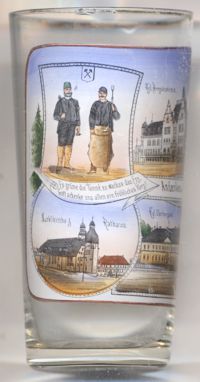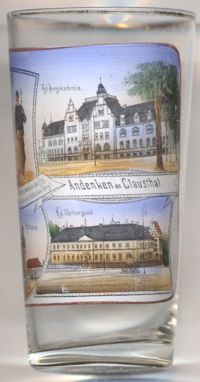

|
| DEUTSCHLAND | GERMANY |
| Bundesland: Niedersachsen | Lower Saxony |
| Landkreis: Goslar |
Clausthal-Zellerfeld is situated at an elevation of 560 m in the southwestern part of the Harz mountains on the Upper Harz Plateau, about 13 km southwest of the district town Goslar and about 76 km southeast of Hannover, the capital of German's state of Lower Saxony. The municipality was formed in 1924 by a merger of the formerly independent municipalities of Clausthal and Zellerfeld. The neighbouring community of Buntenbock was incorporated into the municipality in 1972. In 2015, the Samtgemeinde (collective municipality) Oberharz with its constituent municipalities of Bergstadt Clausthal-Zellerfeld, Bergstadt Altenau, Bergstadt Wildemann and Schulenburg im Oberharz was dissolved to form the current municipality of Clausthal Oberharz. The municipality has a population of about 15,300 (2022). The municipality has the official epithet 'Berg- und Universitätsstadt', i.e. 'mining and university town'.
Mining in the area began in the 16th century. Modern wire rope was invented to service the iron mines in the 1830s by the German mining engineer Wilhelm Albert in the years between 1831 and 1834 for use in mining in the Harz Mountains in Clausthal. It was quickly accepted because it proved superior to ropes made of hemp or to metal chains, such as had been used before and soon found its way into diverse applications, including most notably, suspension bridges. The Innerste Valley Railway was inaugurated in 1877 and extended to Altenau in 1914. The large station building and 70 other buildings in the town were destroyed in an air raid in 1944. Mining activity halted in 1930 because the ore deposits were exhausted. Today, there are large remains of mines in the surrounding Harz region, some of which are now museums. The railway line was closed in 1976. The former railway station, which was rebuilt in 1961–1963 now houses the tourist information and the municipal library today. The Clausthal University of Technology was established in 1775 for the education of mining engineers. Today, it is a technical university for teaching engineering, natural science (especially chemistry, materials science and physics), computer science and business studies.

 The
The  Königliche Bergakademie [glass no. 4573: top right picture] (Royal Mining Academy) was established
in 1775 in Clausthal as the academy of the local mining authority in the Electorate of Hannover. Initially a school for pitmen and smelter workers, it was raised
to the status of a mining college in 1810 during the period of the Kingdom of Westphalia (client state of France). In 1864, at the behest of King George V
of Hannover, the spin-off of a mining academy (Bergakademie) was founded. Both institutions remained under joint administration after the annexation of the
Hannover by Prussia in 1866, until in 1906 the academy was separated as an autonomous educational establishment directly subordinate to the Prussian government.
It was one of only two mining academies in Prussia, the other being the mining college in Berlin established in 1770. After World
War II, the academy passed under the authority of the West German state of Lower Saxony, it was renamed Technische Hochschule in 1966 and
Technische Universität in 1968.
Königliche Bergakademie [glass no. 4573: top right picture] (Royal Mining Academy) was established
in 1775 in Clausthal as the academy of the local mining authority in the Electorate of Hannover. Initially a school for pitmen and smelter workers, it was raised
to the status of a mining college in 1810 during the period of the Kingdom of Westphalia (client state of France). In 1864, at the behest of King George V
of Hannover, the spin-off of a mining academy (Bergakademie) was founded. Both institutions remained under joint administration after the annexation of the
Hannover by Prussia in 1866, until in 1906 the academy was separated as an autonomous educational establishment directly subordinate to the Prussian government.
It was one of only two mining academies in Prussia, the other being the mining college in Berlin established in 1770. After World
War II, the academy passed under the authority of the West German state of Lower Saxony, it was renamed Technische Hochschule in 1966 and
Technische Universität in 1968.
The former  Königliches Oberbergamt (Royal Upper Mining Authority) [lower right picture] was established
in 1866/1867 from the Hannover Mining and Forestry Office. Together with the other Prussian mining authorities, it was subordinate to the Prussian Ministry
of Trade and Industry as an intermediate authority. Its geographical area of responsibility included a large part of the areas annexed by Prussia in 1866,
namely the provinces of Schleswig-Holstein, Hannover and the former Electorate of Hesse. In 2002, the Oberbergamt Clausthal-Zellerfeld
was renamed Landesbergamt Clausthal-Zellerfeld.
Königliches Oberbergamt (Royal Upper Mining Authority) [lower right picture] was established
in 1866/1867 from the Hannover Mining and Forestry Office. Together with the other Prussian mining authorities, it was subordinate to the Prussian Ministry
of Trade and Industry as an intermediate authority. Its geographical area of responsibility included a large part of the areas annexed by Prussia in 1866,
namely the provinces of Schleswig-Holstein, Hannover and the former Electorate of Hesse. In 2002, the Oberbergamt Clausthal-Zellerfeld
was renamed Landesbergamt Clausthal-Zellerfeld.
The Lutheran  Market Church of the Holy Spirit [lower left picture: left] is the historic main church of
Clausthal. Built in 1639–1642, it is the largest wooden church in Germany and, thanks to its architecture and furnishings, is one of the most important
architectural monuments of the North German Baroque. In 1689–1691 it was enlarged by 12 metres at its eastern end. In addition, its outer walls
were moved sideways and a second gallery was added. Further modifications were made in 1734– 1736. Extensive renovations of the exterior parts of
the church were made in 2001–2013, and of the interior in 2016–2021.
Market Church of the Holy Spirit [lower left picture: left] is the historic main church of
Clausthal. Built in 1639–1642, it is the largest wooden church in Germany and, thanks to its architecture and furnishings, is one of the most important
architectural monuments of the North German Baroque. In 1689–1691 it was enlarged by 12 metres at its eastern end. In addition, its outer walls
were moved sideways and a second gallery was added. Further modifications were made in 1734– 1736. Extensive renovations of the exterior parts of
the church were made in 2001–2013, and of the interior in 2016–2021.
The  town hall of Clausthal [lower left picture: background rightt] was built around 1730 in Classicist style
by the architect Tobias Henry Reetz after the former town hall had been destroyed by a large fire in 1725. Today it is still the town hall of
Clausthal-Zellerfeld.
town hall of Clausthal [lower left picture: background rightt] was built around 1730 in Classicist style
by the architect Tobias Henry Reetz after the former town hall had been destroyed by a large fire in 1725. Today it is still the town hall of
Clausthal-Zellerfeld.
The top left picture on glass no. 4573 shows two miners; the reads "Es grüne die Tanne, es wachse das Erz, Gott schenke und allen
ein fröhliches Herz" ('Let the fir tree green, let the ore grow, God grant everyone a cheerful heart'), which is the beginning of a traditional
folk song, the author of which is unknown.
[https://de.wikipedia.org/wiki/Clausthal-Zellerfeld, https://en.wikipedia.org/wiki/Clausthal-Zellerfeld;
https://de.wikipedia.org/wiki/Technische_Universit%C3%A4t_Clausthal, https://en.wikipedia.org/wiki/Clausthal_University_of_Technology;
https://de.wikipedia.org/wiki/Landesamt_f%C3%BCr_Bergbau,_Energie_und_Geologie;
https://de.wikipedia.org/wiki/Marktkirche_zum_Heiligen_Geist;
https://www.denkmalschutz.de/denkmal/rathaus-clausthal-zellerfeld.html;
https://www.volksliederarchiv.de/es-gruene-die-tanne-es-wachse-das-erz/]
![[scale]](lineal.jpg)